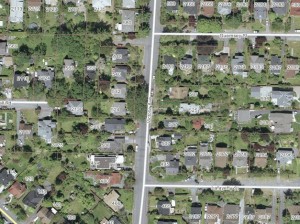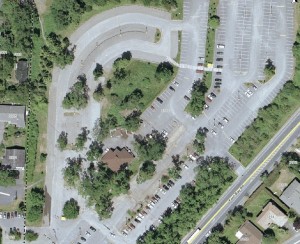
Another piece of Oak Bay’s urban forest was lost this week. A large Garry Oak in the 500 block of Victoria Avenue was removed because it was diseased and thus was a potential risk to falling over. Given it was around 300 years old, age does tend to catch up to even the best of us. But this tree did not really die of old age. It was felled by root rot. What caused the root rot? Well, the story in the Oak Bay News lays it all out:
A younger Garry oak might have been able to fend off the disease, but the Victoria Avenue tree’s age and damage done to it when the street was widened in the 1970s weakened the root system left the oak vulnerable to disease. (emphasis added)
Thats right. It was killed because the road needed to be wider. What can clearly be seen from the photo to the right above is that the road and sidewalk ran almost right against the trunk. As evidenced by this case, driving on a trees roots damages them via soil compaction. But how far out do they extend? A good rule of thumb is the that the roots extend at least as far as the branches or crown does, often further in urban areas. (The Southern Nevada Water Authority has a good graphic and explanation).

Of course, Oak Bay is not the only offender. Parking lots are great places to see just how bad it can get for these poor trees. Case in point; the parking lot at Camosun’s Lansdowne Campus as seen to the left. Formerly a Garry Oak meadow, the trees remain but the grass is now concrete.
The Garry Oak ecosystem is amongst the most endangered in the world and its centerpiece species, the Garry Oak, the only native oak west of Manitoba.
Coincidentally, a lady from the Garry Oak Ecosystem Recovery Team was at Oak Bay council on Monday night looking for some funding to help print their book, The Garry Oak Gardener’s Handbook (PDF link).Thankfully council was able to give them about $200 for 40 copies. She also had a few on hand, so I picked one up and having read through, I highly recommend it. I am looking forward to the newer, larger, edition coming out later this year.
Photo credits: CRD’s Natural Areas Atlas